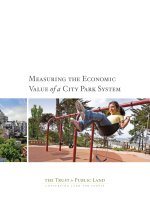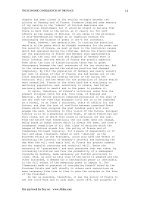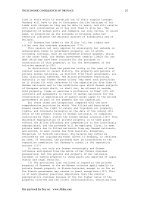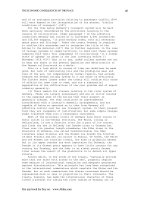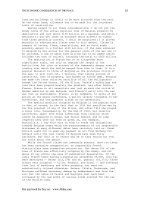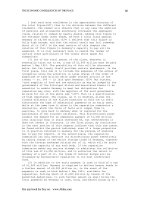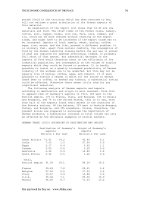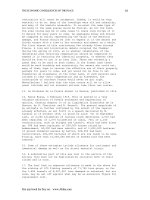The economic integration of roman italy
Bạn đang xem bản rút gọn của tài liệu. Xem và tải ngay bản đầy đủ của tài liệu tại đây (7.84 MB, 531 trang )
The Economic Integration of Roman Italy
Mnemosyne
Supplements
history and archaeology
of classical antiquity
Series Editor
Hans van Wees (University College London)
Associate Editors
Jan Paul Crielaard (Vrije Universiteit Amsterdam)
Benet Salway (University College London)
volume 404
The titles published in this series are listed at brill.com/mns-haca
The Economic Integration
of Roman Italy
Rural Communities in a Globalizing World
Edited by
T.C.A. de Haas
G.W. Tol
leiden | boston
Cover illustration: Reconstruction drawing of the 2nd/1st century bc rural site of San Martino in southern
Tuscany. Image courtesy of Studio InkLink.
The Library of Congress Cataloging-in-Publication Data is available online at
LC record available at />
Typeface for the Latin, Greek, and Cyrillic scripts: “Brill”. See and download: brill.com/brill-typeface.
issn 2352-8656
isbn 978-90-04-32590-6 (hardback)
isbn 978-90-04-34502-7 (e-book)
Copyright 2017 by Koninklijke Brill nv, Leiden, The Netherlands.
Koninklijke Brill nv incorporates the imprints Brill, Brill Hes & De Graaf, Brill Nijhoff, Brill Rodopi and
Hotei Publishing.
All rights reserved. No part of this publication may be reproduced, translated, stored in a retrieval system,
or transmitted in any form or by any means, electronic, mechanical, photocopying, recording or otherwise,
without prior written permission from the publisher.
Authorization to photocopy items for internal or personal use is granted by Koninklijke Brill nv provided
that the appropriate fees are paid directly to The Copyright Clearance Center, 222 Rosewood Drive,
Suite 910, Danvers, ma 01923, usa. Fees are subject to change.
This book is printed on acid-free paper and produced in a sustainable manner.
Contents
List of Figures and Tables ix
Notes on Contributors xvi
Introduction 1
Gijs Tol and Tymon de Haas
part 1
The Economic, Social and Geographic Context
1
The Benefits of Market Integration: Five Centuries of Prosperity in
Roman Italy 15
Willem Jongman
2
The Global Roman Countryside: Connectivity and Community 28
Robert Witcher
3
The Geography of Roman Italy and Its Implications for the
Development of Rural Economies 51
Tymon de Haas
part 2
Arable Production and Society
4
Something Old, Something New: Social and Economic Developments
in the Countryside of Roman Italy between Republic and Empire 85
Alessandro Launaro
5
The Diversification and Intensification of Italian Agriculture: The
Complementary Roles of the Small and Wealthy Farmer 112
Geoffrey Kron
6
Modelling Crop-Selection in Roman Italy. The Economics of
Agricultural Decision Making in a Globalizing Economy 141
Frits Heinrich
vi
7
contents
Peasant Agricultural Strategies in Southern Tuscany: Convertible
Agriculture and the Importance of Pasture 170
Kim Bowes, Anna Maria Mercuri, Eleonora Rattigheri,
Rossella Rinaldi, Antonia Arnoldus-Huyzendveld,
Mariaelena Ghisleni, Cam Grey, Michael MacKinnon and
Emanuele Vaccaro
part 3
Rural Crafts
8
Issues in the Study of Rural Craft Production in Roman Italy 203
J. Theodore Peña
9
Italic Sigillata Production and Trade in Rural Central Italy: New Data
from the Project ‘Excavating the Roman Peasant’ 231
Emanuele Vaccaro, Claudio Capelli and Mariaelena Ghisleni
10
Crafts and Trade in Minor Settlements in North and Central Italy:
Reflections on an Ongoing Research Project 263
Sara Santoro†
part 4
Commercialization
11
Wine and Amphorae in Campania in the Hellenistic Age: The Case of
Ischia 299
Gloria Olcese
12
Rural, Urban and Suburban Communities and Their Economic
Interconnectivity in Coastal North Etruria (2nd Century bc–2nd
Century ad) 322
Marinella Pasquinucci and Simonetta Menchelli
13
The Role of Overseas Export and Local Consumption Demand in the
Development of Viticulture in Central-Adriatic Italy (200 bc–ad 150).
The Case of the Ager Potentinus and the Wider Potenza Valley 342
Dimitri Van Limbergen, Patrick Monsieur and Frank Vermeulen
vii
contents
14
From Surface Find to Consumption Trend: A Ceramic Perspective on
the Economic History of the Pontine Region (Lazio, Central Italy) in
the Roman Period 367
Gijs Tol
15
Wood and Charcoal for Rome: Towards an Understanding of Ancient
Regional Fuel Economics 388
Robyn Veal
16
Where Were the Coins We Find Actually Used? 407
Michael Crawford
part 5
Conclusions
17
Roman Economic Practice across Time and Space: An Outside
Perspective 417
Gary M. Feinman
18
Landscape Archaeology in Italy: Past Questions, Current State and
Future Directions 426
Peter Attema
Bibliography
Index 501
437
List of Figures and Tables
Figures
1.1
1.2
1.3
1.4
3.1
3.2
3.3
3.4
3.5
3.6
3.7
3.8
4.1
4.2
4.3
4.4
5.1
Population trends in the Rhineland (data after Zimmermann et al.
(2009)) 19
Population trends based on data from field surveys around Nettuno and
Albegna (data after De Haas et al. (2011) and Fentress (2009)) 20
Animal bone assemblages from Roman Italy (bones divided from top to
bottom into pig, sheep/goat and cattle, deposited per century; data after
King (1999)) 23
Amphora and fine ware consumption per capita in the Nettuno area
(data after De Haas et al. (2011)) 24
Organization of the production system (after Dicken and Lloyd (1990,
Fig. i.3)) 53
Distribution of urban populations in Roman Italy: town size figures as
proxies (a) and derived estimates of population potential (approximate
boundaries of the Augustan regions in grey) (b) 60
Distribution of minor centres (black dots) in Italy (a) and Lazio and
Campania (b) in relation to two hours’ walking distance buffers (red in a)
around urban centres 64
Roads, rivers and ports in Roman Italy 66
Accessibility of major roads and navigable rivers 69
Betweenness centrality (light to dark squares represent sites with
increasingly high centrality values) and clustering (marked in different
colours) of sites in Roman Italy 71
Distribution of amphora production sites in Italy (the dashed line marks
the presumed limits of olive cultivation; after Horden and Purcell (2000,
14)) 74
Ceramic production sites in Lazio (data after Olcese (2012)) 78
Location and list of survey projects (reproduced from Launaro (2011a, 104
Fig. 5.1)) 88
Overall trends for the rural free population of Roman Italy (200bc to
ad100) (after Launaro (2011a, 161, Fig. 6.4)) 89
Overall trends for the rural free population of Roman Italy for n1000 (left)
and f1000 (right) as centred on villas 94
Increase in the number of villas across n5000 and f5000 as centred on
towns 103
Sizes of excavated small farmhouses in Roman Italy (For the references
for this sample (n = 56), see appendix 1) 124
x
6.1
6.2
6.3
6.4
6.5
6.6
7.1
7.2
7.3
7.4
7.5
7.6
7.7
7.8
7.9
8.1
8.2
8.3
8.4
8.5
8.6
8.7
list of figures and tables
Crop chronology for Egypt from the Neolithic to the present. Cappers and
Neef (2012, 408); Figure courtesy of R.T.J. Cappers 148
Crop chronology for Sardinia from the Early Neolithic to the medieval
period (Figure by the author; data after Bakels (2002, 4/6)) 149
The threshing products of emmer wheat and hard wheat 152
Crop chronology for pre-Roman Italy from the Neolithic to the preRoman Iron Age, based on data from four studies with a multi-site
regional archaeobotanical approach (except for the study on pre-Roman
Pompeii) 158
‘Unrefined’ example of crop-selection in Roman Italy based on several
studies 160
Tentative generalized model of crop-selection in Roman Italy based on
‘refined’ data from Fig. 6.4, showing separate models for northern and
southern Italy 162
Map showing 2nd century bc–1st century ad scatters and off-sites,
Cinigiano (gr), Tuscany (M. Ghisleni) 174
Map showing the five excavated sites of 1st century bc–1st century ad
date discussed in the text 175
Plan of excavated remains, Case Nuove 178
Plan of surface and magnetrometry surveys, and excavated remains, Colle
Massari 180
Plan of excavated remains, San Martino 181
Reconstruction drawing, San Martino (Studio InkLink) 182
Plan of excavated remains, Poggio dell’Amore 183
Plan of excavated remains, Podere Terrato 184
Soil suitability map of the study area, showing location of excavated sites
(A. Arnoldus-Huyzendveld) 189
Schematic representation of five craft production zones posited in
text 205
Map of Central Italy showing locations of four representative cases of
pottery production discussed in text 214
Plan of excavation of Chiusi Marcianella pottery production facility (after
Pucci and Mascione (2003, Fig. 36)) 217
Cutaway reconstruction of Chiusi Marcianella pottery production facility
from northwest (c. 150–100bc) (Pucci and Mascione (2003, Fig. 37)) 217
Plan of excavation of Scandicci Vingone pottery production facility (after
Shepherd et al. (2008, Fig. 13)) 220
Plan of excavation of Scopietto pottery production facility (after
Bergamini (2007, Fig. 5)) 222
Cutaway reconstruction of Scoppieto pottery production facility from
north (after Bergamini (2007, Fig. 6)) 223
list of figures and tables
8.8
9.1
9.2
9.3
9.4
9.5
9.6
9.7
9.8
9.9
9.10
9.11
9.12
10.1
xi
Plan of excavation of villa at La Mola di Monte Gelato. (after Potter and
King (1997, Fig. 13)) 225
Location of Podere Marzuolo in the territory of Cinigiano (southern
Tuscany), the Roman sites excavated by the Excavating the Roman
Peasant Project between 2009 and 2013 and surface scatters and off-sites
identified in Cinigiano during systematic field surveys between 2006 and
2008 (gis map by Emanuele Vaccaro) 233
Visualization of the excavated Roman evidence at Podere Marzuolo on
the arp (Automatic Resistivity Profiling) survey carried out on the
northern and south-western surface scatters. The three scatters
composing the large site at Podere Marzuolo are in white colour (gis
map by Emanuele Vaccaro) 234
Kilns of uncertain function from Areas 11000 and 12000; they were all
found completely empty (gis plan by Emanuele Vaccaro) 235
Distribution of the Italic sigillata production sites so far identified in
central Italy (based upon Olcese (2012)) (gis map by Emanuele
Vaccaro) 237
Nos. 1–20: sample of ‘experimental’ sigillata forms of local production
from Area 11000; nos. 21–22: imported ‘experimental’ sigillata from Area
11000 (drawings by Emanuele Vaccaro) 240
Nos. 1–5: stamps (sex and sexti) on local; ‘experimental’ sigillata; no. 6:
typical ‘dotted’ pattern on local ‘experimental’ sigillata (photos by
Emanuele Vaccaro) 242
Perforated and non-perforated clay plates from the early to mid-Augustan
ceramic assemblages in Area 11000 (photo by Emanuele Vaccaro) 243
a) View of the stack composed of Conspectus 3 dishes at the time of
excavation; b) view of the all Italic sigillata assemblage from Context
10093; c) partially reconstructed stacks of forms (from left to right)
Conspectus 4.6.1, two modules of Conspectus 34 and Conspectus 3.3 with
firing defects increasing from the bottom to the top; d) overfired dishes
Conspectus 20.4 and Conspectus 21.3 (photos by Paolo Nannini) 245
Sample of Italic sigillata vessels produced at Marzuolo by manneivs
(drawings by Emanuele Vaccaro) 249
Repertoire of Italic sigillata vessels referable to a.m.vrbanvs,
l.hvmbricivs h ( ), t.rvfrenvs and non-stamped chalices and pyxides
with their lids (drawings by Emanuele Vaccaro) 251
Amphorae and coarse ware from two excavated contexts near the Italic
sigillata deposit 253
Microphotographs of representative samples (images by Claudio
Capelli) 255
The two Adriatic regions, Abruzzo and Friuli, compared 265
xii
10.2
10.3
10.4
10.5
10.6
10.7
10.8
10.9
10.10
11.1
11.2
11.3
11.4
11.5
11.6
11.7
12.1
12.2
12.3
12.4a–b
13.1
13.2
13.3
list of figures and tables
Plan of the Bliesbruck-Reinheim vicus (after Petit et al. (2013)) 266
Roman settlement pattern in Abruzzo (Antonelli et al. (in press)) 272
Funerary relief from Sulmona (Abruzzo), 1st century bc 272
Sea and river harbours and embankments on the Abruzzo coast (after
Staffa (2002)) 274
Plan of the Centurelli vicus (after D’Alessandro et al. (2011)) 275
The four Augustean Regions of Northern Italy (after Fraccaro
(1947)) 282
Funerary stele of wine merchant Veiquasius Optatus, 1st century ad
(Museo Archeologico di Torino) 284
Plan of the Bedriacum—Calvatone vicus (after Bacchetta and Grassi
(2010)) 288
Roman settlements in the mountains of Friuli (Santoro (2007)) 292
Map of Ischia (after Olcese (2010, 11)) 300
Vineyards on Ischia (after Olcese (2010, 17)) 302
Typology of the Graeco-Italic amphorae from Ischia (after Olcese (2010,
24)) 304
Main groups of amphorae from Ischia and Naples as identified by cluster
analysis of the chemical characterization (xrf) (after Olcese (2010,
196)) 306
Various stamps in Greek on Ischian Graeco-Italic amphorae (after Olcese
(2010)) 308
Distribution of amphorae stamped zo or zoil (after Olcese (2010,
129)) 312
Shipwrecks of Italian origin (end 4th century bc–1st century ad) (after
Olcese (2013, 132)) 320
The study area 323
Hypothetical routes of the main Roman roads in the study area (after
Pasquinucci and Ceccarelli Lemut (1991)) 326
Schematic geological map showing the location of the north-Etruscan
workshops 331
The Isola di Migliarino Potters’ List (a), as transcribed by Camodeca
(2006) (b) 336
Map of Potentia and its immediate surroundings, with indication of the
amphora workshops 346
Upper part of an amphora of the transition type Graeco-Italic to
Lamboglia 2 produced in the workshop of Acquabona (ager Potentinus);
c. 100bc 348
Lamboglia 2 amphora with stamp on the rim of Diodorus from the House
of the Porch at Ostia; first quarter 1st century bc (After Van der Werff
(1986, pl. iii, 4, n. 23)) 349
list of figures and tables
13.4
13.5
13.6
13.7
13.8
13.9
13.10
13.11
13.12
14.1
14.2
14.3
14.4
14.5
14.6
14.7
14.8
14.9
14.10
14.11
xiii
Handle fragment of a Dressel 2–4 amphora found in the workshop of
Acquabona (ager Potentinus) and possibly produced there; 1st century
ad 349
The four Roman towns in the Potenza valley (After Vermeulen and
Mlekuz (2012, Fig. 20.6)) 350
Store-rooms and living quarters in the Acquabona workshop (ager
Potentinus): walls built with sherds of Lamboglia 6a and b amphorae;
Augustan period 351
Possible land requirements in the Potenza valley in relation to the
territories of the towns (km²) 360
Land requirements for cereals in the lower Potenza valley in relation to
the coastal plain (km²) 360
Low-trained vines without a support, usually placed in vine plantations
of the vinea-type (After Bastiani (1851)) 362
High-trained vines wedded to a tree, typically for an arbustum (After
Bastiani (1851)) 362
Small subsistence vineyard in the middle Potenza valley near Treia 364
Abandoned alberata-field in the middle Potenza valley near San Severino
Marche 365
The location of the Pontine region and the five case study areas discussed
(map by T. de Haas) 369
Cumulative trend of all dated amphora rims in the five case studies
combined (n = 352) 372
Cumulative trend of all dated amphora rims in the five case studies
combined, by area of provenance (n = 352) 372
Cumulative trend of all dated table ware rims in the five case studies
combined (n = 908) 375
Settlement development and pottery consumption in the Nettuno
area 378
Settlement development and pottery consumption in the Astura
area 379
Pottery consumption at Forum Appii 381
Settlement development and pottery consumption in the lower Pontine
plain 381
Settlement development and pottery consumption in the Norba
area 383
Cumulative trend of all amphora rims by provenance in the Nettuno area
(top) and at Forum Appii (bottom) 384
Occurrence of Leptiminus 1, Tripolitanian 1 and Catalan Dressel 2–4
amphorae in the Pontine region (map by T. de Haas) 385
xiv
list of figures and tables
Tables
3.1
4.1
4.2
5.1
5.2
5.3
5.4
5.5
5.6
5.7
5.8
6.1
6.2
6.3
6.4
7.1
7.2
9.1
9.2
Ceramic production sites in Lazio (data after Olcese (2012)) 79
Some of the more recent demographic estimates for Roman Italy (in
millions) 87
An extreme (and unrealistic) scenario: the relationship between the highest
levels of demand proposed so far and an agricultural system entirely and
exclusively based on the exploitation of rural slave labour (* the area required
for olive cultivation is not included in the total figure: see main text) 99
Illustrative examples of intensive and extensive agricultural regimes 116
The expansion of small farmhouses 126
Farms with wine or oil processing or storage equipment 127
Decoration in small farmhouses 128
Most common species of game from Roman sites 132
Game as a percentage of meat consumption 133
Prices of game meat (Diocletian’s price edict) 134
Kitchen refuse from Insula 30, Augusta Raurica (after Schibler et al. (1988
80–92; 156)) 135
Weight per volume for various hulled, hulled but dehusked, and naked cereals
(data by the author) 151
Proportional inedible volume per unit for various hulled and naked cereal
species (data by the author). As naked cereals are edible in their entirety, no
measurement was required. Experiments have shown that in the case of hulled
barley (either 2-Row or 6-Row) removing the husk before consumption is
optional, not necessary (see Cappers et al. (2014)) 153
Sample calculation applying the data on emmer wheat and durum wheat from
table 6.2 to a 50,000 modius freighter. Note that it is highly unlikely that emmer
wheat was dehusked prior to transport 154
Sample calculation applying the data on emmer wheat and durum wheat from
table 6.2 to a 500kg cartload. Note that it is highly unlikely that emmer wheat
was dehusked prior to transport 155
The five sites discussed in the text, with a summary of surface survey and
excavated data 176
Selected sums and taxa from archaeobotanical data (pollen percentages; non
pollen palynomorphs and microscopical charcoal particles concentrations;
number of seeds and fruits found in the examined litres of sediments) 191
Quantified ceramic classes from the early to mid Augustan dumps in Area 11000
(mni = Minimum Number of Individuals) 238
List of the Italic sigillata stamps documented at Podere Marzuolo and Torrita di
Siena (mni = Minimum Number of Individuals) 247
list of figures and tables
xv
12.1 Settlement trends in a sample area surveyed in the coastal ager Volaterranus
(After Iacopini et al. 2012) 332
14.1 Number of amphora fragments and types in each of the five case studies 377
14.2 Number of table ware fragments and types in each of the five case studies 377
Notes on Contributors
Antonia Arnoldus-Huyzendveld
is Owner/Founder of digiter, Inc.
Peter Attema
is Professor in Classical and Mediterranean Archaeology in the Department of
Archaeology at the University of Groningen.
Kim Bowes
is Associate Professor in Classics at the University of Pennsylvania.
Claudio Capelli
is Member of the Department of Earth, Environment and Life Sciences at the
University of Genova.
Michael Crawford
is Emeritus Professor of Ancient History at University College London.
Gary Feinman
is the MacArthur Curator of Anthropology at the Field Museum of Natural
History in Chicago.
Mariaelena Ghisleni
is an Independent Researcher.
Cam Grey
is Associate Professor of Classical Studies at the University of Pennsylvania.
Tymon de Haas
is Postdoctoral Researcher at “Research Training Group 1878 Archaeology of
Pre-Modern Economies” at the University of Cologne.
Frits Heinrich
is completing his PhD in Classical and Mediterranean Archaeology at the
University of Groningen and is an Adam Smith Fellow in Political Economy
at the Mercatus Center at George Mason University.
notes on contributors
xvii
Willem Jongman
is Reader in the Economic and Social History of the Roman Empire at the
University of Groningen.
Geoffrey Kron
is Associate Professor in the Department of Greek and Roman Studies at the
University of Victoria.
Alessandro Launaro
is Lecturer in Classical Archaeology in the Faculty of Classics at the University
of Cambridge and a Fellow of Gonville and Caius College.
Dimitri Van Limbergen
is Postdoctoral Research Assistant in the Department of Archaeology at Ghent
University.
Michael MacKinnon
is Professor in Classics and Anthropology at the University of Winnipeg.
Simonetta Menchelli
is Professor of Ancient Topography and Underwater Archaeology at the University of Pisa.
Anna Maria Mercuri
is Associate Professor in Palaeobotany at the Università degli Studi di Modena
e Reggio Emilia.
Patrick Monsieur
is Curator of the Archaeological Museum and Research Staff Member in the
Department of Archaeology at Ghent University.
Gloria Olcese
is Professor of Methods of Archaeological Research in the Department of
Sciences of Antiquity at Sapienza University of Rome.
Marinella Pasquinucci
was Professor of Ancient Topography and Maritime Archaeology at the University of Pisa and currently teaches Ancient Topography at the Scuola di Specializzazione in Beni Archeologici at the University of Florence.
xviii
notes on contributors
J. Theodore Peña
is Professor of Roman Archaeology in the Department of Classics at the University of California, Berkeley.
Eleonora Rattigheri
is Associated Researcher at the Università degli Studi di Modena e Reggio
Emilia.
Rossella Rinaldi
is Associated Researcher at the Università degli Studi di Modena e Reggio
Emilia.
Sara Santoro †
was Professor of Archaeology at the University of Chieti Pescara.
Gijs Tol
is Lecturer in Roman Archaeology at the University of Melbourne.
Emanuele Vaccaro
is Contract-Researcher at the University of Siena and Member of the Laboratory of Landscape Archaeology and Remote Sensing at the University of Siena.
Robyn Veal
is an Affiliate Researcher at the McDonald Institute for Archaeological Research, University of Cambridge, and an Honorary Research Associate at the
Department of Archaeology, University of Sydney.
Frank Vermeulen
is Full Professor in Roman Archaeology and Archaeological Methodology, and
Chair of the Department of Archaeology at Ghent University.
Robert Witcher
is Associate Professor in the Department of Archaeology at Durham University.
Introduction
Gijs Tol and Tymon de Haas
The volume that lies before you constitutes the proceedings of a two-day conference held in late November 2013 at the Royal Dutch Institute in Rome. The
conference took place in the context of the five-year research project ‘Fora, stationes and sanctuaries: the role of minor centres in the economy of Roman
Central Italy’ (in short: the Minor Centres Project). This project, itself part of
the University of Groningen’s long-running Pontine Region Project,1 aims to
investigate the role of minor centres or nucleated non-urban sites in the settlement system and economy of Roman Italy.2 The purpose of the conference was
to provide us with critical feedback and contextualization of our own research
on rural economies, which uses approaches common in landscape archaeological studies, within the broader field of studies on the Roman rural economy. Over the past decades this field has witnessed much new and innovative
work in which high-quality data have been generated, novel approaches have
been developed, and where archaeological and ancient historical scholarship
have increasingly converged. This introduction highlights the main methodological and conceptual advancements that have been made in the field and
subsequently discusses some key themes within this general development as
reflected by the chapters in this volume. Although these key themes are relevant for rural landscapes throughout the Roman world, this introduction and
the volume as a whole concentrate on the countryside of Roman Italy, reflecting the geographic focus of the Minor Centres Project itself.
1
The Study of Roman Rural Economies: Status Quo
Substantial archaeological fieldwork, starting in the 1950s and booming from
the 1970s onwards, continues to enrich our view of the Roman countryside and
rural economies.3 Excavations, whether in the context of rescue operations or
of scientific projects, have contributed to a better understanding of the range
1 Attema (1993); Attema et al. (2010); Attema et al. (2011).
2 See Tol et al. (2014) and Santoro (this volume) for a discussion of the term.
3 The term ‘rural economies’ here refers to economic activities taking place in the countryside
irrespective of its relation to urban centres.
© koninklijke brill nv, leiden, 2017 | doi: 10.1163/9789004345027_002
2
tol and de haas
and complexity of rural settlement.4 In addition, an ever-growing number of
field survey datasets allows us to reconstruct local and regional trajectories in
settlement and economy for many parts of Roman Italy and the wider Roman
world.5
Not only the amount, but also the quality and diversity of data have increased substantially with the introduction of new field methodologies and
analytical techniques. In the context of landscape archaeology, we may point to
the rise of intensive off-site field methods and, more recently, the widespread
application of geophysical prospection and geo-archaeological and palaeoenvironmental studies. In excavations of Roman rural sites, we witness a shift
of interest from the larger and richer sites (e.g. villas) towards an exploration
of also smaller and more ephemeral establishments. Methods such as ecological sampling are gaining ground, whereas advancements in digital recording,
such as photogrammetry, allow careful documentation and analysis of excavated sites. Similarly, the availability of new, and relatively cheap, scientific
techniques in material culture studies, such as handheld xrf, open up new
avenues of research.
Recently acquired archaeological data have allowed us to increase our
understanding of rural economies in two main ways. First, while interpretations of sites and regions were traditionally based on a restricted range of
evidence, these can now be enriched by integrating different types of high quality data, ranging from regional palaeogeographical and climatological data to
site-based artefactual and ecofactual evidence from excavation. Such integration, although methodologically challenging, has the potential to enhance and
indeed transform our understanding of rural sites, landscapes and regions. To
give an example, field surveys produce comprehensive sets of dots on maps,
presumably representing farms and villas and by implication productive agricultural landscapes. Although extremely useful, such maps are also problematic in that they mask a much more complex and dynamic reality, with different
agricultural activities taking place at multiple locations rather than just one,
and also involving non-agricultural activities (e.g. ceramic production, storage)
that may not be easily traceable using traditional survey methods.6 A systematic integration of survey evidence with geophysical, geo-archaeological and
4 One obvious advance has been the growing number of excavated farms, as presented on Fasti
and its associated online journal Fold&r ( />serieshome&ste_cd=FOLDER-it, accessed April 7th 2015). See also Rathbone (2008) and Kron
(this volume).
5 See contributions in Attema et al. (2002); Alcock and Cherry (2004a).
6 Cf. contributions in Attema and Schörner (2012).
introduction
3
ecological data is therefore crucial to better understand the range of site types
present, as is more detailed investigation of the actual activities and agricultural strategies that took place.7
Second, as robust and rich regional datasets are amassing, we can start to
compare them in order to produce supra-regional syntheses of developments
in rural settlement and economy that allow the identification of both general
trajectories and regionally and micro-regionally specific socio-economic and
demographic developments.8 While practical challenges relating to data integration and interpretation are still considerable, systematic comparisons of site
densities, typologies and chronologies, off-site distributions, and the circulation of individual ceramic wares and shapes have become within reach. Such
comparative analyses will enable us to evaluate regional variations in agricultural strategies, non-agricultural activities and connectivity in light of Roman
territorial expansion and economic development and integration.9 By putting
archaeological datasets at centre stage, historians and archaeologists alike have
begun to re-address the grand debates in ancient economic history.10 By systematically analysing archaeological data in light of concepts such as connectivity, globalization, integration and economic growth and performance,
a much richer and more complex picture is emerging of how the expansion
of Rome’s power in the Mediterranean transformed both social relations and
economic systems.11
7
8
9
10
11
As is well illustrated by the Excavating the Roman Peasant Project; see Bowes et al. (this
volume); Ghisleni et al. (2011); Vaccaro et al. (2013).
For one such attempt, see Witcher (2006a).
Leitch (2013); see also Tol (this volume).
The historical debate is still greatly indebted to the works of Moses Finley (1973) and
Keith Hopkins (1978a). In their wake, historians have long sought to characterize the
Roman economy in terms of its supposed primitivist or, conversely, modernist character,
with a particular emphasis on the implications for rural demographic developments (cf.
the so-called High Count—Low Count discussion) and modes of production. The use
of archaeological data in support of such views has generally been limited, although
archaeologists have long tended to concentrate on specific types of rural settlement
(e.g. villas), and have sought to interpret these in specific (Marxist) frameworks; see e.g.
Carandini (1985a) and (1989a).
On socio-economic and demographic developments, see Launaro (2011a) and De Ligt
(2012a). For the use of archaeological data as proxies for economic performance and
growth, see Bowman and Wilson (2009a) and Facta 5 (2011); on the concepts of globalization, connectivity and integration, see Pitts and Versluys (2015) and contributions therein;
Scheidel (2014). See also Jongman (this volume) and Feinman (this volume).
4
tol and de haas
The contributions to this volume form a clear reflection of the developments
outlined above. They present research carried out by both ancient historians
and archaeologists of various backgrounds; they present both new data and
new methodologies as well as fresh synthetic perspectives on existing datasets
from different parts of Roman Italy. They also discuss different analytical scales,
ranging from the single site to the entire Roman peninsula and illustrate well
the two trends (the integration of data types and the comparison and synthesis of datasets) signalled above. We hope that together they demonstrate
the potential of multi-method, multi-disciplinary and multi-scalar approaches,
which in our view are key to a better understanding of the Roman rural economy.
Roughly following the thematic set-up of the conference, we have arranged the
chapters around three key aspects of rural economies: agricultural production
and socio-economic developments, crafts and commercialization (discussed
in parts 2–4).12 They are preceded by three chapters (part 1) that discuss the
broader economic, social and geographic context in which the Roman rural
economy developed, and are followed by two chapters that reflect on the main
issues discussed in the volume (part 5).
2
The Economic Integration of Rural Communities: The Economic,
Social and Geographic Context
Whilst we have briefly sketched the context in which the contents of this
volume should be considered, three chapters discuss aspects of this wider
setting in more detail.
In the first chapter, economic historian Willem Jongman emphasizes the
crucial role of archaeology to provide the (aggregate) data necessary to address
some of the main long-term developments (demography, economic (per
capita) growth and decline) relevant to historical studies in general and to the
Roman period in particular, presenting several examples to demonstrate this
potential. At the same time, he reminds us that the rise and apex of the Roman
economy, the main focus of the contributions in this volume, are not the only
subjects worthy of study, but that its decline deserves equal attention.
12
Some (or even many) of the papers address two or even all three of these themes. We have
placed these under the theme to which we felt they contributed most.
introduction
5
The other two contributions in this section place the processes of economic
integration of the Italian countryside into a broader socio-economic and geographic context. In his chapter, Rob Witcher uses Michael Woods’ concept of
the ‘global countryside’ and its main characteristics to study the character and
development of rural landscapes in Roman Italy. By zooming in on two socioeconomic issues, community and connectivity, he argues against the definition
of a single Roman countryside. Instead, he emphasizes that different local and
regional trajectories towards rural integration occurred, being influenced by
different push-and-pull factors working on diverse societal scales.
A similar conclusion is reached by Tymon de Haas using an economicgeographic perspective. By focusing on the economic processes of demand, distribution, circulation and production (both agricultural and non-agricultural),
he argues that local and regional geographic conditions, the distribution of
population, the characteristics of infrastructural networks and the availability
of natural resources, provided differential potential for rural economic development and integration. At the same time, the available data seems to suggest
that in both core areas and more remote regions rural populations became integrated into supra-regional exchange systems, albeit in different ways.
Together these contributions illustrate two things: first, how the study of
the Roman rural economy can benefit from applying perspectives from other,
related disciplines (e.g. economic geography, the social sciences); and second,
that based on theoretical considerations and presently available archaeological
data, we should indeed expect Roman rural communities to have been characterized by overall high levels of economic integration, although the level and
pace with which this occurs may vary considerably according to local circumstances.
3
Theme 1: Agricultural Production and Socio-Economic
Developments
Agriculture, as the primary economic sector, has traditionally been the main
object of investigation in studies of Roman rural economies and other complex pre-industrial societies. Our understanding of Roman agriculture has long
relied primarily on historical evidence: excavation data served to illustrate the
historical models of agricultural production,13 and the study of agricultural
practices themselves was based primarily on information derived from written
13
Giardina and Schiavone (1981).
6
tol and de haas
sources.14 As such, agricultural studies have somewhat lagged behind the ecological approaches that have long been common in the study of other regions
and periods. However, a recent increase in the systematic use of archaeozoological and botanical data is now producing new insights in (pastoral and arable)
land use, crop choices, and complementary activities such as game farming
and sylviculture. Such data in turn inform us on the production strategies of
both small farmers and large estate holders and the extent to which these were
part of market-oriented production systems. The four chapters of part 2 use different analytical scales (from a single site to a region) and deal with different
source materials (literary, botanical, artefactual) to illustrate the potential of
archaeological data to address these issues.
In his contribution, Alessandro Launaro provides an excellent example of how
the integration of regional archaeological datasets can help to revise longstanding socio-economic models of the Roman rural economy. By combining
the results of a number of survey projects he challenges the widely held view
that the rise of large (slave-based) villa estates, observable in many parts of
Italy from the 2nd century bc onwards, occurred at the expense of the local
peasantry. On the contrary, the ubiquitous increase in the numbers of large villa
estates throughout Italy that emerges from Launaro’s study appears to have
been accompanied by stabilization of or even an increase in the number of
recorded farmsteads. A rise in the number of villa estates is only one of the
effects (along with urban embellishment in towns and villages) of a period of
increased wealth among elites, which may have trickled down to lower social
strata.
Based on very different data (zoological assemblages from farm and villa
excavations), Geoffrey Kron likewise identifies a growing prosperity of both
elite estate holders and owners of small to medium-size farms and emphasizes their interdependence in meeting the demands of both urban and rural
markets. Whereas small farmers possessed extensive knowledge of local market and farming conditions and could occasionally be hired as labour, wealthier
farmers were in a (financial) position to take more risks, which stimulated innovation. Kron discusses game farming as an example of such an innovation. After
initially having been the domain of a few elite landowners, the market for game
expanded over time and game production intensified, thereby coming within
the reach of different echelons of society.
14
E.g. White (1970); Spurr (1986).
introduction
7
The next two chapters both illustrate the substantial potential of environmental, and particularly botanical research to advance our understanding of
how farmers adapted their agricultural strategies according to differing geographic and economic conditions. Frits Heinrich discusses crop selection
strategies in Roman Italy as compared to other parts of the Roman Empire.
Botanical evidence suggests that a shift from emmer to hard wheat took place
in the grain-producing regions of the Empire, stimulated by the favourable
properties of the latter in terms of cultivation, transportation and processing.
In contrast, crop chronologies suggest that Italian farmers adopted a more balanced, and less risky, strategy of producing multiple crops, and that they were
less inclined to select crops on the basis of productivity-related factors only.
Heinrich relates these strategies to the relatively favourable market conditions
for Roman farmers, who were exempt from taxes and resided in close proximity
to the major markets, which would have led to a greater emphasis on highvalue cash crops and allowed smallholders to engage in economic activities of a
non-agricultural nature. He acknowledges that he is largely constrained to use
botanical data that derives from urban rather than rural contexts and that the
collection of data from such rural production contexts will be crucial to test
these hypotheses.
In this light, Kim Bowes et al. present important new work undertaken in
the context of the Roman Peasant Project. Excavation of five small sites (identified during previous surface surveys), thought to constitute lower-class rural
households, revealed a wide range of activity areas, including field drains and
temporary shelters; remarkably, only one could be interpreted as a permanent
habitation site. Together, the evidence points to a period of agricultural intensification during the Late Republican and Early Imperial period. Systematic
botanical sampling suggests that convertible agriculture may have been an
important agricultural strategy in this period. At the same time, the excavation data warn against the uncritical use of survey data for site classifications
and, by extension, demographic calculations. Also, they problematize the common assumption that agricultural regimes were uniform throughout a region.
Their work thus shows that detailed local studies are crucial to critically evaluate attempts at generalization at larger spatial scales.
4
Theme 2: Crafts
While agricultural production has traditionally received much attention, other
aspects of rural economies such as crafts, industries, and resource exploitation
as well as the provision of services have remained poorly studied. As is clear
